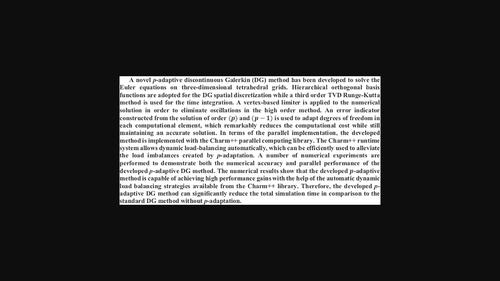当前位置:
X-MOL 学术
›
Int. J. Numer. Methods Fluids
›
论文详情
Our official English website, www.x-mol.net, welcomes your feedback! (Note: you will need to create a separate account there.)
A parallel p-adaptive discontinuous Galerkin method for the Euler equations with dynamic load-balancing on tetrahedral grids
International Journal for Numerical Methods in Fluids ( IF 1.8 ) Pub Date : 2023-08-21 , DOI: 10.1002/fld.5231 Weizhao Li 1 , Aditya K. Pandare 2 , Hong Luo 1 , Jozsef Bakosi 2 , Jacob Waltz 2
International Journal for Numerical Methods in Fluids ( IF 1.8 ) Pub Date : 2023-08-21 , DOI: 10.1002/fld.5231 Weizhao Li 1 , Aditya K. Pandare 2 , Hong Luo 1 , Jozsef Bakosi 2 , Jacob Waltz 2
Affiliation

|
A novel p-adaptive discontinuous Galerkin (DG) method has been developed to solve the Euler equations on three-dimensional tetrahedral grids. Hierarchical orthogonal basis functions are adopted for the DG spatial discretization while a third order TVD Runge-Kutta method is used for the time integration. A vertex-based limiter is applied to the numerical solution in order to eliminate oscillations in the high order method. An error indicator constructed from the solution of order and is used to adapt degrees of freedom in each computational element, which remarkably reduces the computational cost while still maintaining an accurate solution. The developed method is implemented with under the Charm++ parallel computing framework. Charm++ is a parallel computing framework that includes various load-balancing strategies. Implementing the numerical solver under Charm++ system provides us with access to a suite of dynamic load balancing strategies. This can be efficiently used to alleviate the load imbalances created by p-adaptation. A number of numerical experiments are performed to demonstrate both the numerical accuracy and parallel performance of the developed p-adaptive DG method. It is observed that the unbalanced load distribution caused by the parallel p-adaptive DG method can be alleviated by the dynamic load balancing from Charm++ system. Due to this, high performance gain can be achieved. For the testcases studied in the current work, the parallel performance gain ranged from 1.5× to 3.7×. Therefore, the developed p-adaptive DG method can significantly reduce the total simulation time in comparison to the standard DG method without p-adaptation.
中文翻译:

四面体网格动态负载平衡欧拉方程的并行p自适应间断伽辽金法
开发了一种新颖的p自适应间断伽辽金 (DG) 方法来求解三维四面体网格上的欧拉方程。DG空间离散采用分层正交基函数,时间积分采用三阶TVD Runge-Kutta方法。基于顶点的限制器应用于数值解,以消除高阶方法中的振荡。由阶数解构造的误差指标和用于调整每个计算元素的自由度,这显着降低了计算成本,同时仍然保持准确的解决方案。所开发的方法是在Charm++并行计算框架下实现的。Charm++ 是一个并行计算框架,包括各种负载平衡策略。在 Charm++ 系统下实现数值求解器为我们提供了一套动态负载平衡策略。这可以有效地用于减轻p适应造成的负载不平衡。进行了大量的数值实验来证明所开发的p自适应 DG 方法的数值精度和并行性能。据观察,并行p自适应 DG 方法引起的负载分布不平衡可以通过 Charm++ 系统的动态负载平衡来缓解。因此,可以获得高性能增益。对于当前工作中研究的测试用例,并行性能增益范围为 1.5 倍到 3.7 倍。因此,与没有p自适应的标准 DG 方法相比,所开发的p自适应 DG 方法可以显着减少总模拟时间。
更新日期:2023-08-21
中文翻译:

四面体网格动态负载平衡欧拉方程的并行p自适应间断伽辽金法
开发了一种新颖的p自适应间断伽辽金 (DG) 方法来求解三维四面体网格上的欧拉方程。DG空间离散采用分层正交基函数,时间积分采用三阶TVD Runge-Kutta方法。基于顶点的限制器应用于数值解,以消除高阶方法中的振荡。由阶数解构造的误差指标和用于调整每个计算元素的自由度,这显着降低了计算成本,同时仍然保持准确的解决方案。所开发的方法是在Charm++并行计算框架下实现的。Charm++ 是一个并行计算框架,包括各种负载平衡策略。在 Charm++ 系统下实现数值求解器为我们提供了一套动态负载平衡策略。这可以有效地用于减轻p适应造成的负载不平衡。进行了大量的数值实验来证明所开发的p自适应 DG 方法的数值精度和并行性能。据观察,并行p自适应 DG 方法引起的负载分布不平衡可以通过 Charm++ 系统的动态负载平衡来缓解。因此,可以获得高性能增益。对于当前工作中研究的测试用例,并行性能增益范围为 1.5 倍到 3.7 倍。因此,与没有p自适应的标准 DG 方法相比,所开发的p自适应 DG 方法可以显着减少总模拟时间。



























 京公网安备 11010802027423号
京公网安备 11010802027423号